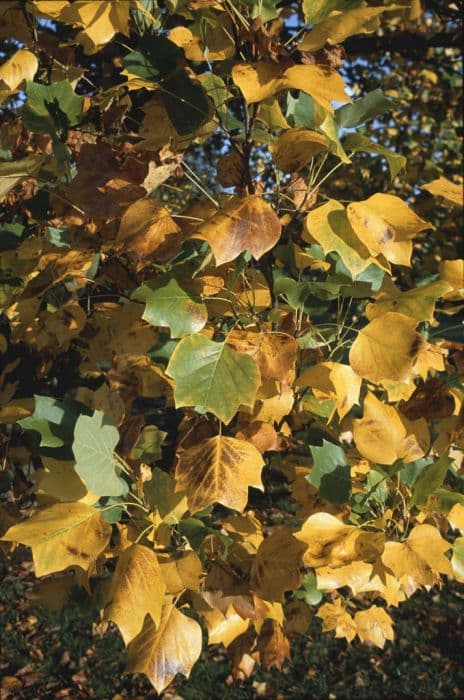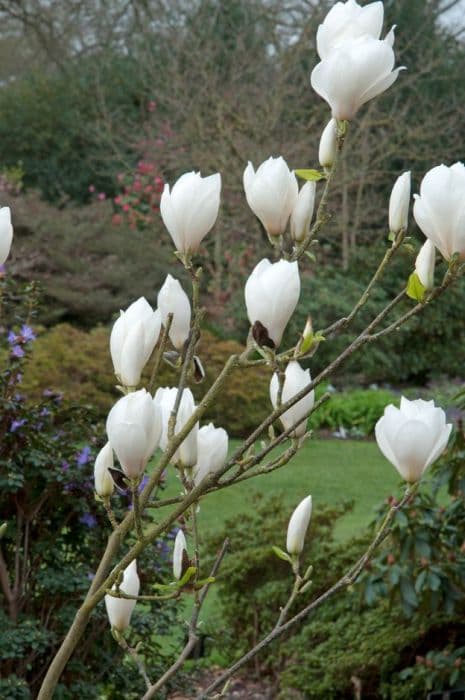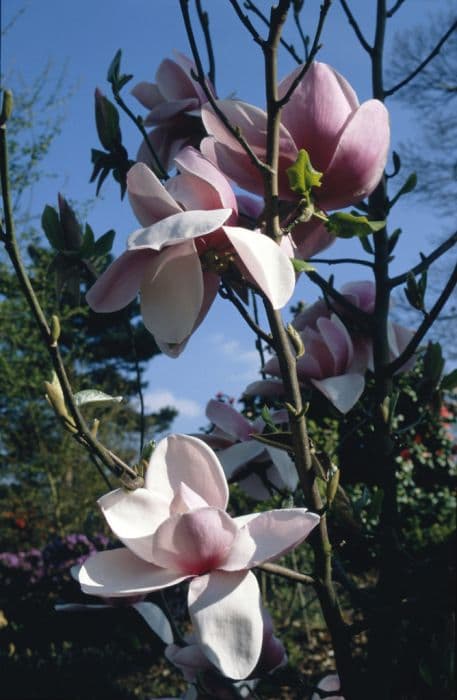Saucer Magnolia Magnolia × soulangeana 'Rustica Rubra'

ABOUT
The Magnolia × soulangeana 'Rustica Rubra', commonly known as the Saucer Magnolia, is a highly esteemed ornamental plant known for its striking floral display. This plant is a deciduous shrub with a multi-stemmed habit that often grows in a rounded shape. Its most prominent feature is the large, cup-shaped flowers that bloom profusely in the early spring, before the foliage emerges. The flowers of the Saucer Magnolia 'Rustica Rubra' are particularly captivating, with their deep pink to reddish-purple exterior and a paler, almost white interior. Each blossom is made up of six waxy petals that can span up to several inches across, forming an impressive saucer-like shape that has become the plant's namesake. As the seasons change, the Saucer Magnolia offers an evolving display of beauty. The flowers give way to lush green leaves that provide a dense canopy of foliage. The leaves are typically broad and oval-shaped with a smooth margin, offering a backdrop that frames the stunning flowers in spring. In the fall, the foliage undergoes a transformation, with the green leaves turning shades of yellow and bronze, adding to the autumn landscape before they finally drop. Even without the leaves, the bare branches of the Saucer Magnolia present an elegant silhouette in the landscape during the wintertime. With its remarkable flowers and attractive foliage, the Saucer Magnolia 'Rustica Rubra' is a cherished addition to many gardens and public spaces, offering a delightful spectacle across the seasons.
About this plant
 Names
NamesSynonyms
Saucer Magnolia, Tulip Magnolia, Chinese Magnolia, Japanese Magnolia
Common names
Magnolia × soulangeana 'Rustica Rubra'.
 Toxicity
ToxicityTo humans
Saucer Magnolia is not considered toxic to humans. Ingesting parts of this plant typically does not lead to poisoning or serious side effects, although individual allergies and sensitivities may still cause mild discomfort if ingested or if the sap comes into contact with the skin.
To pets
Saucer Magnolia is also not considered toxic to pets. It is not known to cause poisoning or serious health issues in pets if they ingest parts of the plant. However, it's always good practice to prevent pets from eating plants as individual animals may have unique sensitivities or reactions.
 Characteristics
CharacteristicsLife cycle
Perennials
Foliage type
Deciduous
Color of leaves
Green
Flower color
Pink
Height
20 feet (6 meters)
Spread
25 feet (7.62 meters)
Plant type
Tree
Hardiness zones
5
Native area
Hybrid
Benefits
 General Benefits
General Benefits- Ornamental Beauty: Saucer magnolia is known for its showy, large pink-purple flowers that bloom in spring, adding aesthetic appeal to any landscape.
- Spring Interest: With its early spring blossoms, this magnolia variety provides a burst of color after the dull winter months, signaling the onset of warmer weather.
- Shade Provider: As the saucer magnolia matures, it can offer a moderate amount of shade due to its spreading canopy.
- Habitat for Wildlife: Provides nectar for pollinators in early spring and can serve as a habitat for birds and other small wildlife.
- Drought Resistance: Once established, this magnolia variety has some resistance to drought, reducing the need for frequent watering.
- Urban Tolerance: Capable of tolerating urban pollution, making it a suitable choice for city planting.
- Year-Round Interest: Beyond its striking spring blooms, the saucer magnolia has attractive deciduous foliage that changes color in the fall.
 Medical Properties
Medical PropertiesThis plant is not used for medical purposes.
 Air-purifying Qualities
Air-purifying QualitiesThis plant is not specifically known for air purifying qualities.
 Other Uses
Other Uses- Magnolia × soulangeana 'Rustica Rubra', commonly known as Saucer Magnolia, can be used in floral arrangements, where its branches and blooms create an elegant and dramatic display.
- The bark of the Saucer Magnolia can be utilized in the production of natural dyes, offering shades ranging from greenish to brown hues, depending on the mordant used.
- Wood from the Saucer Magnolia is sometimes used in woodworking for making small, decorative items due to its fine grain and workability.
- These trees can serve as a natural noise barrier when planted in rows, helping to reduce traffic and urban sounds.
- The Saucer Magnolia's large petals are suitable for creating eco-friendly confetti or decorations for outdoor celebrations.
- During blooming season, the flowers can provide a dramatic backdrop for photography, serving as a natural photo booth for events and portrait sessions.
- Fallen petals and leaves can be used as organic mulch, providing a nutrient-rich cover that helps retain soil moisture and inhibit weed growth.
- Saucer Magnolia leaves can be used in art projects, like leaf pressing or botanical prints, due to their size and distinctive shape.
- The sturdy branches are suitable for use in supporting climbing plants or vegetables in a garden setting.
- In some cultures, the Saucer Magnolia tree is planted in memory of loved ones, serving as a living tribute that changes with the seasons.
Interesting Facts
 Feng Shui
Feng ShuiThe Saucer Magnolia is not used in Feng Shui practice.
 Zodiac Sign Compitability
Zodiac Sign CompitabilityThe Saucer Magnolia is not used in astrology practice.
 Plant Symbolism
Plant Symbolism- Dignity: The Magnolia x soulangeana 'Rustica Rubra', commonly known as Saucer Magnolia, often symbolizes dignity due to its impressive and stately appearance.
- Feminine beauty: With its large cup-shaped flowers, the Saucer Magnolia is frequently associated with the soft, delicate beauty commonly attributed to femininity.
- Persistence: The tree’s hardiness and perennial nature are emblematic of persistence and endurance.
- Purity: The clean and elegant look of the Saucer Magnolia’s blooms often stands for purity and innocence.
- Nobility: Associated with nobility and high social status, the tree's name and its historical presence in estate gardens play into this symbolism.
 Water
WaterSaucer Magnolia should be watered deeply, with enough water to soak the root zone. For young trees, this typically means applying about 1-2 gallons once a week during the growing season, reducing frequency to every two weeks in cooler weather. During hot, dry periods, increase the frequency to twice a week. Mature trees may require less frequent but more voluminous watering, depending on rainfall and soil conditions. Always allow the top inch of soil to dry out between watering to ensure you are not overwatering.
 Light
LightSaucer Magnolia thrives in full sun to partial shade. The ideal spot would provide morning sunlight with some afternoon shade, especially in hotter climates. Ensure the plant receives at least 4-6 hours of direct sunlight daily to promote healthy growth and bloom production.
 Temperature
TemperatureSaucer Magnolia should be grown in areas where temperatures range between 20°F and 90°F. They can tolerate short bursts of colder temperatures down to 0°F but may suffer damage if the cold is sustained. Ideally, maintain a temperature range of 40°F to 70°F for optimal growth.
 Pruning
PruningSaucer Magnolia benefits from pruning to maintain its shape and remove any broken or diseased branches. The best time for pruning is late summer to early fall after blooming has ceased, as pruning in winter or early spring can reduce the number of flowers. Prune sparingly, as the tree does not require heavy cutting back, and focus on enhancing its natural form.
 Cleaning
CleaningAs needed
 Soil
SoilSaucer Magnolia thrives in rich, well-drained, and slightly acidic soil with a pH ranging from 5.5 to 6.5. The best soil mix can be made from equal parts loam, peat moss, and compost to ensure adequate drainage and fertility.
 Repotting
RepottingSaucer Magnolia typically does not require frequent repotting as it is a slow-growing tree. Young trees can be repotted every 2-3 years, while mature trees may only need repotting every 5 years or when rootbound.
 Humidity & Misting
Humidity & MistingSaucer Magnolia benefits from moderate humidity levels but is adaptable to varying conditions. It generally prefers an outdoor setting where natural humidity is sufficient.
 Suitable locations
Suitable locationsIndoor
Place in bright, indirect light; ensure a large pot.
Outdoor
Plant in well-draining soil; full sun to partial shade.
Hardiness zone
4-9 USDA
 Life cycle
Life cycleMagnolia × soulangeana 'Rustica Rubra', commonly known as Saucer Magnolia, begins its life cycle when a seed germinates, usually requiring exposure to warm then cold temperatures to break dormancy. The seedling emerges and establishes roots, developing into a juvenile plant with foliage that matures over several years. As it becomes an adult tree, it develops a woody trunk and branches with the characteristic large, broad leaves. The Saucer Magnolia enters its reproductive stage, producing large saucer-shaped flowers that are pink to reddish-purple, typically blooming in early spring before the leaves emerge. After pollination, usually by beetles attracted to the flowers, it sets seeds encased in cone-like fruit structures that, when mature, release the seeds to start a new generation. The tree can live for many years, going through a cycle of dormancy during winter and regrowth in the spring, maintaining its reproductive capabilities well into maturity.
 Propogation
PropogationPropogation time
Spring-Early Summer
The preferred method for propagating the Saucer Magnolia (Magnolia × soulangeana 'Rustica Rubra') is via softwood cuttings. This is typically done in late spring or early summer when new growth is still tender. To do this, gardeners should select a healthy, non-flowering shoot and cut a 4-6 inch (approximately 10-15 cm) length, ensuring that there are at least two sets of leaves. The lower leaves are removed and the cut end is dipped into rooting hormone to encourage root development. The cutting is then planted in a pot filled with a mix of peat and perlite, covering the pot with a plastic bag to retain humidity. The cutting should be kept in a warm place with indirect light and the soil should be kept moist but not wet. Roots typically develop within a few weeks to a few months, after which the new plant can be transferred to a larger pot or directly into the garden.









